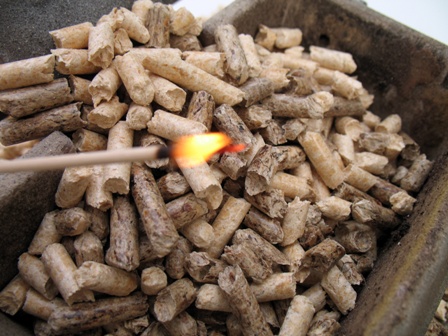 Geneva
GenevaWood energy accounts for 3% of the total primary energy supply (TPES) and 47% of the renewable energy supply (RES) in the UNECE region[1] in 2009, confirming its role as the leading source of renewable energy. Wood covered almost 20% of the total energy demands of Sweden, Finland and Estonia and accounted for well over half the renewable energy supply in the Nordic and Baltic states as well as in Serbia and the Czech Republic. Around 44% of all mobilised woody biomass supply is used for energy purposes. Despite the increasing rate of wood consumption for energy, the region's forests are increasing in area as well as standing volumes.
These are the main conclusions of the UNECE/FAO Joint Wood Energy Enquiry (JWEE), a biennial questionnaire that aims to shed light on the real role of wood energy within the region by promoting cross-sectoral communication and cooperation between the energy and forestry sectors. Now in its third round since 2005, the JWEE has become a reference source of information on wood energy, drawing responses from an increasing number of countries.
Sources of wood energy
The main sources of wood energy are:
- Co-products and residues[2] from forest-based industries, including processed wood fuels with improved energy content such as wood pellets, briquettes and charcoal (also called indirect sources) contributing 57%
- woody biomass from forests and other wooded land (also known as direct sources) such as logging residues, thinnings and clearings, which represent 40% of consumption.
- recovered waste wood (mainly waste from construction, but also packaging and old furniture) which accounts for 3% of wood energy supply.
However, the proportion of these three sources varies among countries, with Serbia, Italy, France, the Czech Republic, Slovenia, Norway and Russia relying heavily on direct supplies of wood fibres whereas countries such as the United States, Belgium, Sweden, Finland, Estonia, Slovakia, Austria and Ireland rely mainly on wood supply from indirect sources. Finland, Sweden, Slovakia and the United States have large shares of energy generated from black liquor reflecting the relative importance of the pulp and paper industries in the forest sector. Waste wood is reported as a significant source of wood energy in the UK, Ireland, Germany and Switzerland where it is mainly consumed in power applications and waste to energy plants. In general, however, data on recovered wood is difficult to obtain and often not discernible from generic waste statistics.
Uses of wood energy
Wood energy is consumed in roughly equal measure (approximately 39% each) by forest-based industries and households. The highest shares of industrial use are in the United States, Ireland, Slovakia, Belgium, Finland and Sweden. The forest products industry typically consumes energy generated from the solid and liquid co-products of its manufacturing processes. Countries with important forest industries, such as Finland, Sweden and the United States, therefore, have a higher level of industrial consumption.
Residential use, mainly dependent on direct supplies of firewood, is prevalent in Southern and Central Europe with Serbia, France, the Czech Republic, Italy, Lithuania, Germany, Austria and Switzerland reporting this category as their primary use. Wood energy use by private households is often higher than anticipated as it may not be fully accounted for.
The power and heat sector is the most important consumer of wood energy in the United Kingdom, and has relatively large shares in Germany, Sweden and the Baltic region. Overall it represents 20% of wood energy use.
Main Trends
It was possible to identify trends in the use of wood energy and to provide a comparison based on a subset of countries that have responded to previous rounds of the enquiry. Between 2005 and 2009, the amount of wood used for energy purposes grew annually by 2.7%. One of the biggest movers, in relative terms, is the United Kingdom where wood now accounts for 16.3% of renewable energy supply (up from 8.2% in 2005) and 0.52% of total primary energy supply (up from 0.15% in 2005).
The role of wood in total primary energy supply grew whereas a slight decline in the role of wood energy among renewables was recorded. This, perhaps, reflects a faster rate of growth by other sources of renewable energy such as wind and solar. The structure of sources for wood energy has been relatively stable whereas there has been a growing trend to use wood for power and heat combined with a decrease in the use of wood energy in the residential sector.
Further Info:
The complete datasheets can be downloaded at www.unece.org/jwee2009.html. The next round of the enquiry will be launched later this year following a capacity-building event to train national correspondents from participating countries. For any additional comments or questions kindly contact:
David Ellul
Economic Affairs Officer
UNECE/FAO Forestry and Timber Section
Tel: +41 (0)22 917 1390
E-mail: [email protected]
Website: http://www.unece.org/forests
Note to Editors:
The Joint Wood Energy Enquiry was developed in collaboration with the International Energy Agency and Eurostat to address the need for a specialized dataset on wood energy. Wood energy statistics are often concealed within statistics on energy from renewables and waste, and are only available in energy units. The JWEE provides data in units that are readily understandable by the forestry sector, thus enabling a direct comparison between the material and energy uses of woody biomass. It collects data on several streams of woody biomass supply providing valuable information on national and international wood flows.
Black liquor is the liquid material remaining from pulpwood cooking in the papermaking process.


[1] The Enquiry was sent out all the UNECE member states (except Andorra, Monaco and San Marino). Overall 27 countries replied to the enquiry representing 75% of UNECE region's population: 21 countries provided sufficiently detailed replies (Austria, Belgium, Cyprus, Czech Republic, Estonia, Finland, France, Germany, Ireland, Italy, Liechtenstein, Lithuania, Norway, Russian Federation, Serbia, Slovakia, Slovenia, Sweden, Switzerland, United Kingdom and the United States).
[2] These co-products can be solid (sawdust, chips, slabs, etc.) or liquid (e.g. black liquor or tall oil).

